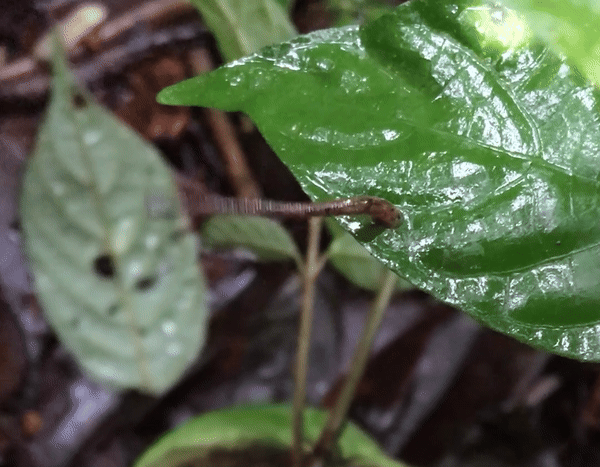Mollusks, Worms, Sponges, Starfish
Scientists Finally Identified This Glowing, Transparent 'Mystery Mollusk' After Nearly 25 Years of Puzzling
The newly described species of sea slug dwells in darkness in the ocean’s midnight zone, using a hood to capture prey with a Venus flytrap-like technique
These Tiny Snails Are Breeding in the Wild for the First Time in 40 Years in French Polynesia
During a release of captive-bred snails in September, researchers discovered wild-born individuals from the Partula tohiveana species—which had been considered extinct in the wild—marking a huge milestone in a global effort to save them
In a First, Scientists Find Animals Thriving Beneath the Ocean Floor in Hidden Habitats Near Deep-Sea Vents
The discovery of worms and snails confirms that these still-mysterious, dark hotspots of life extend beyond what’s visible above the crust
American Scientists Win Nobel Prize in Medicine for 'Groundbreaking' Gene Discovery Made by Studying Worms
Victor Ambros and Gary Ruvkun discovered microRNA, tiny molecules that play a crucial role in how cells develop, paving the way for new treatments for diseases
See Ten Strange and Mesmerizing Creatures From the Deep Ocean, From Sea Toads to Frilled Sharks
Scientists who explore the depths using submersibles continue to discover amazing animals that inhabit dark waters
Watch Octopuses Team Up With Fish to Hunt—and Punch Those That Don't Contribute
The collaboration across species reveals a surprising social behavior of octopuses, researchers say
Rare Jaw Fossils Discovered in Texas Shed Light on a 20-Foot-Long Mosasaur
Unearthed last year, the remains could reveal new information on the extinct sea reptile, which crushed mollusks and shelled creatures with its large, round teeth
Scientists Play Matchmaker for Beloved Sea Snails in the Florida Keys
To boost the iconic queen conch's population, researchers are relocating the heat-stressed creatures to cooler, deeper waters to help them find mates
Parasites Are Everywhere. Why Do So Few Researchers Study Them?
Aging parasitologists are working hard to inspire more students to enter the field
Why Is the Paris Olympics Running Track Purple?
The track incorporates recycled mussel and clam shells in a bid to help make the Summer Games the most sustainable yet
Watch Blood-Sucking Leeches Leap From Leaves and Soar Through the Air
New videos may help settle scientists' long-standing debate over whether leeches can jump
Family Members Infected With Parasitic Worms After Eating Undercooked Bear Meat at Reunion
Six people developed symptoms of roundworm infection after consuming grilled black bear meat and vegetables in July 2022, and all have since recovered
Has the Term 'Keystone Species' Lost Its Meaning?
More than 50 years after Bob Paine’s experiment with starfish, hundreds of species have been pronounced “keystones” in their ecosystems
Ocean Sponge Skeletons Suggest a More Significant History of Global Warming Than Originally Thought
Analysis of the sea creatures’ skeletal chemistry suggests the world’s temperatures have increased by 1.7 degrees Celsius since pre-industrial times
Hermit Crabs Are Using Trash as Shells Across the World, Scientists Find
Researchers analyzed photographs of the crustaceans online, identifying nearly 400 examples of artificial shells, which were often plastic bottle caps
This Eight-Day Festival Celebrates One of Alaska's Weirdest Worms
Welcome to the Cordova Ice Worm Festival, a quirky local tradition honoring the mysterious creatures that live in glacial ice
A Starfish 'Body' Is Just One Giant Head, Study Finds
Genes associated with the torso are largely absent in a species of starfish, upending how scientists perceive these creatures
Parasitic, Invasive Worm Found in Rats in Georgia
While the worm can sicken people, few human infections have been reported in the U.S., and it typically doesn’t require treatment
What's Killing Minnesota's Moose? Studies Reveal Sites of Deadly Brainworm Transmission
Carried by deer and spread by snails and slugs, a lethal parasite is infecting the large ungulates, which have recently declined dramatically
Doctors Pulled a Wriggling, Three-Inch Worm From a Woman's Brain
The incident in Australia is the first known occurrence of the roundworm—typically found in snakes—infecting the brain of a mammal
Page 1 of 7
:focal(960x485:961x486)/https://tf-cmsv2-smithsonianmag-media.s3.amazonaws.com/filer_public/b6/06/b60675be-ad2f-4b5b-b0df-604af3c3a2ad/mystery_mollusc_d0598_02_1920_1.jpg)
:focal(800x602:801x603)/https://tf-cmsv2-smithsonianmag-media.s3.amazonaws.com/filer_public/fa/a5/faa5479c-e74f-4f53-aae7-abe822511c67/born-in-the-wild-unmarked-partula-tohiveana-snail-observed-in-the-wild-meaning-the-species-is-re-established-c-paul-pearce-kelly-2.png)
:focal(600x389:601x390)/https://tf-cmsv2-smithsonianmag-media.s3.amazonaws.com/filer_public/6e/9e/6e9e9540-db4c-4e23-81dd-489764023d84/fkt230629-rocksample_youngtubeworms-20230719-naranjo-04014.jpg)
:focal(3402x2268:3403x2269)/https://tf-cmsv2-smithsonianmag-media.s3.amazonaws.com/filer_public/27/85/278532d8-0090-42d6-9ff6-77449b49da84/gettyimages-2176426457.jpg)
:focal(640x482:641x483)/https://tf-cmsv2-smithsonianmag-media.s3.amazonaws.com/filer_public/f3/9d/f39db89e-ab0a-44a1-abbb-4d60a0eb27da/squid_web.jpg)
:focal(600x340:601x341)/https://tf-cmsv2-smithsonianmag-media.s3.amazonaws.com/filer_public/6a/cc/6acc2d2d-32b9-48fa-92ec-418681f5706c/octopus.jpg)
:focal(425x320:426x321)/https://tf-cmsv2-smithsonianmag-media.s3.amazonaws.com/filer_public/21/4f/214fb752-d077-486e-a6b2-dca284c50163/globidens-alabamaensis.jpeg)
:focal(375x250:376x251)/https://tf-cmsv2-smithsonianmag-media.s3.amazonaws.com/filer_public/ca/e3/cae3da0f-be1b-42ba-a092-86ad7d52a140/queen_conch_noaa.jpeg)
:focal(800x602:801x603)/https://tf-cmsv2-smithsonianmag-media.s3.amazonaws.com/filer_public/58/ed/58ed036d-8bc4-4be2-ae67-d07a0c2e33a6/img_9264_web.jpg)
:focal(2944x1976:2945x1977)/https://tf-cmsv2-smithsonianmag-media.s3.amazonaws.com/filer_public/94/17/9417cb1b-06b3-4eba-b665-a3fc5a222498/gettyimages-2151890911.jpg)

:focal(593x367:594x368)/https://tf-cmsv2-smithsonianmag-media.s3.amazonaws.com/filer_public/b4/fb/b4fb1a7d-b0cf-4cf8-a678-4e0925716aea/mm7320a2-f-large.png)
:focal(800x602:801x603)/https://tf-cmsv2-smithsonianmag-media.s3.amazonaws.com/filer_public/0d/83/0d83e9ef-a8a6-4e91-bd00-72b8764e7440/gettyimages-1176797379_web.jpg)
:focal(1018x679:1019x680)/https://tf-cmsv2-smithsonianmag-media.s3.amazonaws.com/filer_public/92/72/92724eab-a5ad-4096-b776-f60a9353677b/5278175066_1370d67ff4_o.jpg)
:focal(310x220:311x221)/https://tf-cmsv2-smithsonianmag-media.s3.amazonaws.com/filer_public/d0/b9/d0b9ad20-8d78-4ca5-acc2-c841336d3e97/hermitcrab3.png)
:focal(2016x1517:2017x1518)/https://tf-cmsv2-smithsonianmag-media.s3.amazonaws.com/filer_public/95/08/9508d230-a5ed-4a5d-a3ce-53d0017442e1/scotthotaling_6_copy.jpg)
:focal(350x263:351x264)/https://tf-cmsv2-smithsonianmag-media.s3.amazonaws.com/filer_public/82/98/8298ef07-c99c-4da4-8195-d721ff9e7fe7/low-res_gene_expression_patchwork_from_the_paper.png)
:focal(1250x881:1251x882)/https://tf-cmsv2-smithsonianmag-media.s3.amazonaws.com/filer_public/47/8e/478e5b0c-43fa-41fa-bb6f-6b7b707d35d8/gettyimages-51632741.jpg)
:focal(1322x806:1323x807)/https://tf-cmsv2-smithsonianmag-media.s3.amazonaws.com/filer_public/73/06/73065e6b-1740-4600-ab91-24f007a04bb3/74f79759-bcee-4dde-b0cc-95949c525485original.jpg)
:focal(583x288:584x289)/https://tf-cmsv2-smithsonianmag-media.s3.amazonaws.com/filer_public/1e/27/1e2726be-ed90-45f5-959d-212ef00d6c3d/screen_shot_2023-08-29_at_105948_am.png)